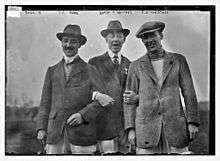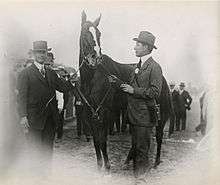Harry Payne Whitney
| Harry Payne Whitney | |
|---|---|
.jpg) Harry Payne Whitney in February 1924 | |
| Born |
April 29, 1872 New York City, United States |
| Died |
October 26, 1930 (aged 58) Portland, Maine |
| Cause of death | Pneumonia |
| Resting place | Woodlawn Cemetery, The Bronx |
| Residence |
871 Fifth Avenue, New York, Old Westbury, New York |
| Education | Groton School |
| Alma mater | Yale University |
| Occupation | Lawyer, Racehorse owner/breeder, philanthropist |
| Known for | Thoroughbred racing |
| Board member of |
Long Island Motor Parkway Hudson Bay Mining & Smelting Co. |
| Spouse(s) |
Gertrude Vanderbilt (m. 1896; his death 1930) |
| Children |
Flora P. Whitney Cornelius V. Whitney Barbara Whitney |
| Parent(s) |
William Collins Whitney Flora Payne |
| Relatives | See Whitney family |

Harry Payne Whitney (April 29, 1872 – October 26, 1930) was an American businessman, thoroughbred horse breeder, and member of the prominent Whitney family.[1]
Early years
Harry Payne Whitney was born on April 29, 1872 in New York City, he was the eldest son of Flora Payne and William C. Whitney (1841–1904), the very wealthy businessman and United States Secretary of the Navy. Harry was the older brother of William Payne Whitney (1876–1927). His sister, Pauline Payne Whitney (1874–1916), was married to Almeric Hugh Paget, 1st Baron Queenborough (1861–1949), and his youngest sister, Dorothy Payne Whitney (1887–1968), was married Willard Dickerman Straight (1880–1918) and later, Leonard Knight Elmhirst (1893–1974), after Straight's death.[1]
Harry Payne Whitney studied at Groton School in Groton, Massachusetts then attended Yale University, graduating with a law degree in 1894. He was a member of the Skull and Bones. In 1904, after the death of his father, he inherited $24,000,000, and in 1917, he inherited approximately $12,000,000 from his uncle, Oliver Hazard Payne.[2]
Life and career
Sportsman
An avid sportsman, he was a ten-goal polo player. His love of the sport was inherited from his father who had been involved with polo when it was first organized in the United States in 1876 by James Gordon Bennett, Jr. H. P. Whitney organized the U. S. polo team that beat England in 1909. "Whitney Field" polo field near Saratoga Springs, New York is named for him. He was also a board member of the Montauk Yacht Club and competed with his yacht Vanitie in the America's Cup. Whitney also served on the board of directors of the Long Island Motor Parkway, built by his wife's cousin, William Kissam Vanderbilt II.[1]
Whitney also enjoyed quail hunting and purchased the 14,000-acre (57 km2) Foshalee Plantation in northern Leon County, Florida from Sydney E. Hutchinson of Philadelphia, Pennsylvania.[3]
Thoroughbred horse racing

Whitney was a major figure in thoroughbred horse racing. He inherited a large stable from his father (including the great filly Artful and her sire Hamburg, and in 1915 established a horse breeding farm in Lexington, Kentucky where he developed the American polo pony by breeding American Quarter Horse stallions with his thoroughbred mares. He was thoroughbred racing's leading owner of the year in the United States on eight occasions and the breeder of almost two hundred stakes race winners. His leading sire was first Hamburg and then the great sire Broomstick, by Ben Brush. His Kentucky-bred horse Whisk Broom II (sired by Broomstick) raced in England, then at age six came back to the U.S. where he won the New York Handicap Triple. He also owned Upset, who gave Man o' War the only loss of his career.
Whitney had nineteen horses who ran in the Kentucky Derby, winning it the first time in 1915 with another Broomstick foal, Regret, the first filly ever to capture the race. Regret went on to earn Horse of the Year honors and was named to the National Museum of Racing and Hall of Fame. Whitney won the Kentucky Derby for the second time in 1927 with the colt Whiskery. His record of six wins in the Preakness Stakes stood as the most by any breeder until 1968 when Calumet Farm broke the record. Whitney's colt Burgomaster won the 1906 Belmont Stakes and also received Horse of the Year honors. Amongst many, Whitney's breeding operation produced Equipoise and Johren.
Whitney's stable won the following prestigious U.S. Triple Crown races:
- Kentucky Derby:
- 1915 : Regret (voted Horse of the Year)
- 1927 : Whiskery
- Preakness Stakes:
- Belmont Stakes:
- 1905 : Tanya (filly)
- 1906 : Burgomaster (voted Horse of the Year)
- 1913 : Prince Eugene
- 1918 : Johren
His Lexington, Kentucky stud farm was passed on to his son, C.V. Whitney, who owned it until 1989 when it became part of Gainesway Farm.
Personal life

On August 25, 1896 he married Gertrude Vanderbilt (1875–1942), a member of the wealthy Vanderbilt family. In New York, the couple lived in town houses originally belonging to William Whitney, first at 2 East 57th St., across the street from Gertrude's parents, and after William Whitney's death, at 871 Fifth Avenue.[4] They also had a country estate in Westbury, Long Island.[5] Together, they had three children:[6][5]
- Flora Payne Whitney (b. 1897)
- Cornelius Vanderbilt Whitney (b. 1899)
- Barbara Whitney (b. 1903).[7]
Harry Whitney died in 1930 at age fifty-eight.[1][8] He and his wife are interred in the Woodlawn Cemetery, The Bronx. TIME magazine reported that at the time of his death, Harry Payne Whitney's estate was appraised by New York State for tax collection purposes at $62,808,000 net.[9]
Philanthropy
The benefactor to many organizations, in 1920 H. P. Whitney financed the Whitney South Seas Expedition of the American Museum of Natural History, Rollo Beck's major zoological expedition that sent teams of scientists and naturalists to undertake botanical research and to study the bird population of several thousand islands in the Pacific Ocean.
The Whitney Collection of Sporting Art was donated in his memory to the Yale University Art Gallery.
References
- 1 2 3 4 Times Wide World (27 October 1930). "H.P. WHITNEY DIES AT 58 OF PNEUMONIA; ILL ONLY A FEW DAYS; Sportsman and Financier Succumbs Unexpectedly at HisFifth Avenue Home.CAUGHT COLD ON TUESDAY His Wife, the Former GertrudeVanderbilt, and Their ThreeChildren at Bedside.HE INHERITED A FORTUNE Built Up Vast Properties and Became One of Nation's Richest Men-- Famed for Racing Stables. One of America's Richest Men. H.P. WHITNEY DIES AT 58 OF PNEUMONIA Heir to Wealth and Prestige. Guggenheim Guided His Start. Known Also as Dog Fancier. Many Concerns Now Merged.". The New York Times. Retrieved 30 November 2016.
- ↑ "Gertrude Vanderbilt Whitney [1875-1942]". New Netherland Institute. Retrieved December 17, 2014.
- ↑ Paisley, Clifton, From Cotton To Quail: An Agricultural Chronicle of Leon County, Florida, 1860-1967, University of Florida Press, 1968. ISBN 978-0-8130-0718-2 pp. 83
- ↑ Adams, Michael Henry. "The Most Palatial House in New York: Stanford White's William Collins Whitney Residence!". Michael Henry Adams, Style and Taste!. Retrieved December 27, 2014.
- 1 2 Magill, Frank N., ed. (1999). "Gertrude Vanderbilt Whitney". Dictionary of world biography. Chicago: Fitzroy Dearborn. pp. 3969–3971. ISBN 1579580483. Retrieved December 27, 2014.
- ↑ Vanderbilt, Arthur T., II (August 1989). Fortune's Children: The Fall of the House of Vanderbilt. New York: Morrow. ISBN 0-688-07279-8. Retrieved December 17, 2014.
- ↑ Gertrude Vanderbilt Whitney at www.nnp.org
- ↑ Vanderbilt, 354.
- ↑ "Harry Payne Whitney, Youthful Guard of Millions; He Says His Life Will Be Devoted to Business -- He May Sell Horses Some Day, but Not Now.". Time Magazine. Retrieved 30 November 2016.
External links
- "Gentleman's Estate". Time Magazine. 1934-07-30. Retrieved 2008-08-09.
- June 5, 1904 New York Times article on Harry Payne Whitney
- Harry Payne Whitney obituary